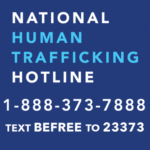Raising Awareness for Human Trafficking Victims:
The Red Sand Project
Human trafficking, or the criminal exploitation of children and adults, has become a major problem in the United States that has come to affect many people. There are about 30 million people trafficked every year on average worldwide. Traffickers typically manipulate people, usually women or children, into sex acts or forced labor by offering them food, drugs, money, or shelter. However, the captors may also use violence and intimidation as a way to prevent victims from contacting law enforcement or leaving. In addition, the scale of the trafficking operation, via a network of traffickers or a powerful cartel, can ensure that a targeted person can be moved with efficiency and with little to no detection. Locations along highways and transportation channels, including hotels and truck stops, are often key spots where trafficking thrives. Though the COVID-19 pandemic disrupted some traditional channels for trafficking, human traffickers quickly adapted to capitalize on the vulnerabilities exposed and exacerbated by the pandemic.
Human Trafficking Has Many Forms
Many people believe that human trafficking is just forced labor or sex work. While these two types of trafficking do make up the majority of all trafficking cases, other forms do exist. In addition to forced labor and sex trafficking, people across the world are trafficked to enter into forced marriages–arrangements where one party has not consented to the relationship, and where physical and emotional abuse are often present. In other cases, people may be trafficked to have their organs harvested, or to participate in warfare.
Human trafficking is an international issue that effects almost everyone. Traffickers tend to target at-risk populations, including individuals who have experienced other forms of violence (such as child abuse and maltreatment, sexual assault, or other violence) and individuals without regular support networks (such as runaway and homeless youth, unaccompanied minors, or people affected by natural disasters). These traffickers use a variety of tactics to coerce or lure their victims, including threats of violence. At the Federal level, victims of human trafficking are protected by the Trafficking Victims’ Protection Act (2000). Trafficked victims are more susceptible to other problems as well; for example, according to the 2020 Federal Human Trafficking Report, 38% of human trafficking victims have some form of substance dependency. Their proximity to violence and other risk factors increases mortality risks too. On average, trafficking victims only live for about 7-10yrs after the point of entering the trafficking trade. Only about 1% of sex trafficking victims survive or have the chance to return home.
The Problem is Everywhere
In Pennsylvania and across the country, human trafficking is an ever growing issue within our communities. For Pennsylvania in particular, Human Trafficking has become a hot button issue amongst state legislatures and concerned citizens as cases continue to increase. A report done by the Human Trafficking Institute noted that, Pennsylvania is ranked fourth in the nation for the number of cases making their way through the state’s federal courts. There has also been a particular concern for keeping children safe from these increasing cases. One sad but notable trend by Pennsylvania law enforcement and activists is that children have been found to be more often than not trafficked by people they know. This has been particularly seen by parents trafficking children for drug money.
The Pennsylvania Coalition Against Rape states that most cases of trafficking in PA are in local communities where the victim lives. Most labor trafficking in PA is in farming, landscaping, panhandling, or begging, while sex trafficking venues are typically bars, escort services (run out of a home or on the street), strip clubs, and massage parlors. In response to rising counts of trafficking, the Pennsylvania state government signed Act 105 (2014) into law, which defines trafficking in PA and gives law enforcement an extra way to punish traffickers and put the victims on a path to recovery.
What Can You Do to Help?
There are multiple ways to combat human trafficking, from donations to spreading awareness, and even developing the necessary skills to recognize and address situations hands-on. Young adults, being at the most risk, should take initiative in learning the warning signs of human trafficking so they can not only prevent it from happening to them, but also their peers. First, you can get to know the organizations in your region that are working to combat the problem. You can volunteer, host an awareness-raising event, help fundraise, or donate your time in many other helpful ways.
 You can also learn to know the warning signs and find out more about who is most at risk for trafficking. Sudden changes in behavior, increased secrecy about personal details or whereabouts, and hyper-vigilant or paranoid behaviors are all potential warning signs that a person has become a victim of trafficking. If you suspect someone might be a victim of trafficking, you can refer them to the National Human Trafficking Hotline, the Pennsylvania Victims’ Services agency, or the Victims’ Resource Center (Wilkes Barre, PA) for help. The human trafficking hotline is a completely anonymous service that is open 24 hours a day for anyone to report anything suspicious.
You can also learn to know the warning signs and find out more about who is most at risk for trafficking. Sudden changes in behavior, increased secrecy about personal details or whereabouts, and hyper-vigilant or paranoid behaviors are all potential warning signs that a person has become a victim of trafficking. If you suspect someone might be a victim of trafficking, you can refer them to the National Human Trafficking Hotline, the Pennsylvania Victims’ Services agency, or the Victims’ Resource Center (Wilkes Barre, PA) for help. The human trafficking hotline is a completely anonymous service that is open 24 hours a day for anyone to report anything suspicious.
Human trafficking is a complex issue, and requires widespread and multifaceted solutions to overcome it. If the general population is more aware on how they can help, human trafficking can be reduced more effectively, and we can prevent people from falling through the cracks. In order to accomplish this goal on a global scale, we first have to focus on our own communities.
About this Project
 In the fall of 2021, students in Dr. Black’s HIS 431 class (American Capitalism and the Global Economy) engaged in a service-learning project to support the Victims’ Resource Center in Wilkes Barre, PA. They planned a two-part event: a public lecture given by Tammi Burke, Manager of Client Services for the VRC, and a Red Sand Project art installation. The students in HIS 431–Alyssa Chesek, Patrick Ciccarino, Justin Moreno, Phil Pisano, Averi Rine, Tavion Rogers, Chase Shustack, Larry Territo, Nora Tracey, Jude Unitis, and Connor Wallace–researched the information presented on this webpage, and designed the posters featured in the slideshow above. Justin Moreno compiled the slideshow and the references on this page. Special thanks also goes to Louise Keller, MU Service-Learning Coordinator; Prof. Rachel Urbanowicz, Department of Mass Communication and Design; Janice O’Brien, Cougar Prints; and Michelle Donato, College of Arts and Sciences, for their support of this project.
In the fall of 2021, students in Dr. Black’s HIS 431 class (American Capitalism and the Global Economy) engaged in a service-learning project to support the Victims’ Resource Center in Wilkes Barre, PA. They planned a two-part event: a public lecture given by Tammi Burke, Manager of Client Services for the VRC, and a Red Sand Project art installation. The students in HIS 431–Alyssa Chesek, Patrick Ciccarino, Justin Moreno, Phil Pisano, Averi Rine, Tavion Rogers, Chase Shustack, Larry Territo, Nora Tracey, Jude Unitis, and Connor Wallace–researched the information presented on this webpage, and designed the posters featured in the slideshow above. Justin Moreno compiled the slideshow and the references on this page. Special thanks also goes to Louise Keller, MU Service-Learning Coordinator; Prof. Rachel Urbanowicz, Department of Mass Communication and Design; Janice O’Brien, Cougar Prints; and Michelle Donato, College of Arts and Sciences, for their support of this project.
Learn More About Human Trafficking
National Human Trafficking Hotline. (n.d.). Retrieved October 8, 2021, from https://humantraffickinghotline.org/.
Feehs, K., & Wheeler, A. C. (2021, July 22). Kyleigh FEEHS. Human Trafficking Institute. Retrieved October 8, 2021, from https://www.traffickinginstitute.org/2020-federal-human-trafficking-report.
Lanier Law Firm (NY). “Trucking and Human Trafficking.” Retrieved January 18, 2022, from https://www.lanierlawfirm.com/trucking-and-human-trafficking/.
Human trafficking resources. Office of Juvenile Justice and Delinquency Prevention. (n.d.). Retrieved October 8, 2021, from https://ojjdp.ojp.gov/programs/human-trafficking-resources.
The Human Trafficking Source. (n.d.). Retrieved October 8, 2021, from https://www.thehumantraffickingsource.com/.
Human Trafficking Resources & Research: OVC. Office for Victims of Crime. (n.d.). Retrieved October 8, 2021, from https://ovc.ojp.gov/program/human-trafficking/resources-research.
Human trafficking. Migration data portal. (n.d.). Retrieved October 8, 2021, from https://www.migrationdataportal.org/themes/human-trafficking.
Resources. The United States Department of Justice. (2017, January 6). Retrieved October 8, 2021, from https://www.justice.gov/humantrafficking/resources.
Victims of human trafficking and other crimes. USCIS. (2017, August 25). Retrieved October 8, 2021, from https://www.uscis.gov/humanitarian/victims-of-human-trafficking-and-other-crimes.












